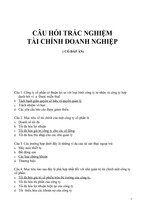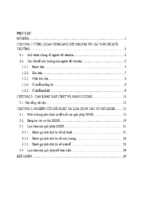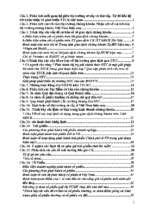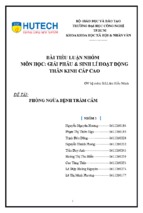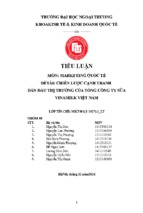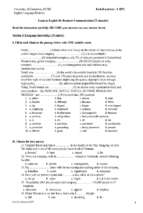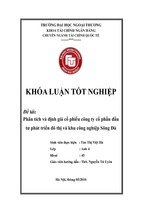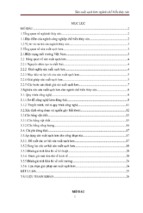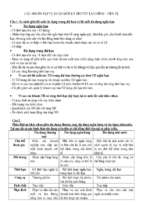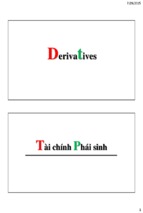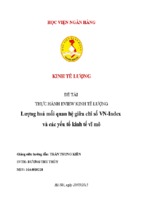Tài lệu này giúp bạn hiểu rõ và sâu hơn về các vấn đề quản trị tài chinh ở các công ty đa quốc gia
The Complete
CFO Handbook
From Accounting to Accountability
Frank J. Fabozzi
Pamela Peterson Drake
ralPh s. Polimeni
John Wiley & Sons, Inc.
Copyright © 2008 by John Wiley & sons, inc. all rights reserved.
Published by John Wiley & sons, inc., hoboken, new Jersey.
Published simultaneously in Canada.
Wiley bicentennial logo: richard J. Paciico
no part of this publication may be reproduced, stored in a retrieval system, or transmitted in any form or by any means, electronic, mechanical, photocopying, recording, scanning, or otherwise, except as permitted under section 107 or 108 of the 1976 United states
Copyright act, without either the prior written permission of the Publisher, or authorization
through payment of the appropriate per-copy fee to the Copyright Clearance Center, inc., 222
rosewood Drive, Danvers, ma 01923, (978) 750-8400, fax (978) 646-8600, or on the web
at www.copyright.com. requests to the Publisher for permission should be addressed to the
Permissions Department, John Wiley & sons, inc., 111 river street, hoboken, nJ 07030,
(201) 748-6011, fax (201) 748-6008, or online at http://www.wiley.com/go/permissions.
limit of liability/Disclaimer of Warranty: While the publisher and author have used their
best efforts in preparing this book, they make no representations or warranties with respect
to the accuracy or completeness of the contents of this book and speciically disclaim any
implied warranties of merchantability or itness for a particular purpose. no warranty may
be created or extended by sales representatives or written sales materials. the advice and
strategies contained herein may not be suitable for your situation. You should consult with a
professional where appropriate. neither the publisher nor author shall be liable for any loss
of proit or any other commercial damages, including but not limited to special, incidental,
consequential, or other damages.
For general information on our other products and services or for technical support, please
contact our Customer Care Department within the United states at (800) 762-2974, outside
the United states at (317) 572-3993, or fax (317) 572-4002.
Wiley also publishes its books in a variety of electronic formats. some content that appears in
print may not be available in electronic books. For more information about Wiley products,
visit our web site at www.wiley.com.
note: the previous edition of this work is titled Cost Accounting: Concepts and Applications
for Managerial Decision Making, third edition.
library of Congress Cataloging-in-Publication Data
Fabozzi, Frank J.
the complete CFo handbook : from accounting to accountablity / Frank
J. Fabozzi, Pamela P. Peterson Drake, ralph s. Polimeni.
p. cm.
includes index.
isbn 978-0-470-09926-1 (cloth)
1. Chief inancial oficers—handbooks, manuals, etc. 2.
Corporations—United states—Finance—handbooks, manuals, etc. i.
Peterson Drake, Pamela, 1954- ii. Polimeni, ralph s. iii. title.
hG4027.35.F33 2007
658.15’1--dc22
2007018191
Printed in the United states of america.
10 9 8 7 6 5 4 3 2 1
FJF
to my wife, Donna, and my children,
karly, Patricia, and Francesco
PPD
to my husband, randy
RSP
to my inspiration, maxine elko
Contents
Preface
About the Authors
CHAPTER 1
The Changing Role of the CFO: From Accounting to Accountable
soX act of 2002 and the CFo
expanded responsibilities of the CFo
our agenda
xv
xix
1
2
6
14
PART ONE
Funding
CHAPTER 2
Capital Structure Decisions
Debt versus equity
Concept of leverage
Capital structure and Financial leverage
Financial leverage and risk
Capital structure and taxes
Capital structure and Financial Distress
Cost of Capital
agency relationship
optimal Capital structure: theory and Practice
a Capital structure Prescription
bottom line
appendix: Capital structure theory—the modigliani-miller
theory and beyond
CHAPTER 3
Types of Debt Financing
General Features of Debt obligations
15
17
18
21
25
29
31
37
41
43
47
51
52
53
63
64
vii
viii
CONTENTS
term loans
syndicated bank loans
notes and bonds
short-term Financing
off-balance-sheet Financing
bottom line
CHAPTER 4
Equity Funding
Common stock
Preferred stock
bottom line
CHAPTER 5
Structured Financing: Asset Securitization and Structured Notes
asset securitization
structured notes
bottom line
65
69
71
86
93
95
99
100
115
121
123
124
139
149
PART TWO
Strategy, Taxes, and Risk Management
CHAPTER 6
Strategy and Financial Planning
strategy and Value
Financial Planning and budgeting
importance of Financial Planning
budgeting Process
sales Forecasting
seasonal Considerations
budgeting
Pro Forma Financial statements
long-term Financial Planning
Financial modeling
Performance evaluation
strategy and Value Creation
bottom line
151
153
155
158
158
160
161
163
165
172
179
179
183
191
195
Contents
CHAPTER 7
Basics of Corporate Taxes and Tax Risk Management
tax management
tax risk
U.s. tax law and taxation of Corporations
state and local taxes
non-U.s. taxes
bottom line
CHAPTER 8
Corporate Risk Management
risk Deined
enterprise risk management
managing risks
risk transfer
bottom line
ix
197
199
200
205
218
218
224
227
228
230
235
237
255
PART THREE
Performance Evaluation
CHAPTER 9
Financial Ratio Analysis
ratios and their Classiication
return-on-investment ratios
liquidity
Proitability ratios
activity ratios
Financial leverage ratios
Common-size analysis
Using Financial ratio analysis
illustration: Pizer, inc., 1990–2005
bottom line
259
261
262
264
271
279
282
284
289
290
292
307
x
CONTENTS
CHAPTER 10
Cash Flow Analysis
Dificulties with measuring Cash Flow
Cash Flows and the statement of Cash Flows
Free Cash Flow
Calculating Free Cash Flow
net Free Cash Flow
Usefulness of Cash Flows in Financial analysis
bottom line
CHAPTER 11
Decentralized Operations and Responsibility Accounting
organization structures and Concepts
examples of types of organization structure and
resposibility reporting
Decentralization Problems
responsibility accounting
Controllable Costs
Costs of service Departments
executive incentive Compensation Plans and Dysfunctional
Decision making
bottom line
CHAPTER 12
Responsibility Center Performance Evaluation
basis for Comparison
Cost Center Performance evaluation
Proit Center Performance evaluation
Proit Center Decision making
investment Center Performance evaluation
bottom line
appendix: Gross Proit analysis
CHAPTER 13
Transfer Pricing
transfer Pricing methods
Dual transfer Pricing system
international transfer Pricing
bottom line
309
309
311
316
318
320
322
327
329
330
331
337
338
345
346
347
351
353
354
356
364
372
373
394
394
405
407
418
419
424
Contents
xi
PART FOUR
Asset Management
CHAPTER 14
Capital Budgeting and Cash Flow Analysis
the investment Problem
Capital budgeting
Cash Flow from investments
bottom line
appendix 14.a: expected Cash Flows from the Disposition
of an asset
appendix 14.b: expansion of the Williams 5 & 10
CHAPTER 15
Capital Budgeting Techniques
evaluation techniques
net Present Value
Proitability index
internal rate of return
modiied internal rate of return
Payback Period
Discounted Payback Period
issues in Capital budgeting
Comparing techniques
Capital budgeting techniques in Practice
Conlicts with responsibility Center Performance
evaluation measures
Capital budgeting and the Justiication of new technology
bottom line
CHAPTER 16
Capital Budgeting and Risk
Project risk
measurement of Project risk
measuring a Project’s market risk
incorporating risk in the Capital budgeting Decision
real options
Certainty equivalents
assessment of Project risk in Practice
bottom line
427
429
430
432
437
454
455
457
463
464
466
471
472
477
480
482
483
486
489
490
491
495
497
498
500
505
514
518
525
526
528
xii
CONTENTS
CHAPTER 17
Leasing
how leasing Works
types of equipment leases
Full-Payout leases versus operating leases
reasons for leasing
types of lessors
lease brokers and Financial advisers
lease Programs
Financial reporting of lease transactions by lessees
leveraged lease Fundamentals
Federal income tax requirements for true lease transactions
synthetic leases
Valuing a lease: the lease or borrow-to-buy Decision
bottom line
CHAPTER 18
Managing Short-Term Assets
Cash management
marketable securities
receivables management
inventory management
bottom line
531
532
533
535
536
541
541
542
543
546
556
558
560
574
579
581
589
591
601
607
PART FIVE
Cost and Managerial Accounting
CHAPTER 19
Classifying Costs
elements of a Product
relationship to Production
relationship to Volume
ability to trace
Department Where incurred
Functional areas
Period Charge in income
relationship to Planning, Controlling, and Decision making
techniques for new Product Cost estimation
bottom line
609
611
612
615
616
622
623
624
625
626
629
633
Contents
CHAPTER 20
Costing and Control of Materials, Labor, and Factory Overhead
materials (stores)
labor
Factory overhead Costs
activity-based Costing
bottom line
CHAPTER 21
Job Order and Process Costing
Comparison of Job order and Process Cost
accumulation systems
Job order Costing
operation Costing
Project Costing
Process Costing
backlush Costing
bottom line
appendix: spoiled Units, Defective Units, scrap material, and
Waste material in Job order and Process Costing systems
CHAPTER 22
Joint Product and By-Product Costing
Joint Products
by-Products
effects of Joint Cost allocation upon Decision making
bottom line
CHAPTER 23
Master Budget
Conventional master budget system
budgeted schedules
budgeted summaries
bottom line
CHAPTER 24
Standard Costing
actual, normal, and standard Costing
Uses of standard Costs
xiii
635
636
641
646
660
664
667
668
669
673
674
676
694
695
697
703
703
711
715
716
719
721
723
740
744
749
750
751
xiv
CONTENTS
types of standards
establishment of standards
Just-in-time Philosophy and Cost accounting
Variance analysis
Disposition of all Variances
bottom line
CHAPTER 25
Direct and Absorption Costing
meaning of Direct Costing
Direct Costing versus absorption Costing
advantages of Direct Costing
Disadvantages of Direct Costing
adjusting Financial statements for external reports
bottom line
Index
752
753
764
769
786
788
791
791
792
802
805
807
807
809
Preface
T
he role of inancial executives in any business has expanded signiicantly
in recent years as companies become more accountable to their stakeholders and regulators. Combine this increase in accountability with the
increasing sophistication of technology, risk management, inancial analysis, and inancial records processing, and we see that the responsibilities of
inancial executives in any organization have expanded signiicantly.
our goal with The Complete CFO Handbook is to provide inancial
executives with the background and tools for managing a company’s inancial functions. the Handbook consists of ive parts, each focusing on a different dimension of the inancial executives’ role.
in Part one we focus on funding issues, including the capital structure
decision, the choice of debt inancing, equity inancing issues, and structured
inancings. We include the traditional capital structure theory and analysis,
but our focus really is on the analysis of what companies do in practice. to
this end, we include coverage of:
■
■
■
■
■
■
■
■
how the sarbanes-oxley act of 2002 affects the responsibilities and the
role of the CFo.
the governance value of debt inancing.
Costs of inancial distress.
Factors to consider when designing a bond issues.
alternative methods of repurchasing stock.
structured inance transactions.
Credit enhancement in securitization.
structured notes.
in Part two we address strategic planning, taxes, and risk management.
the CFo is often playing a larger role in developing and executing the company’s strategic plan, which means taking a broader view of the sources of value
creation and of the company’s risk management strategies. We include coverage
of current issues to help the CFo better prepare for this broader view:
■
■
sources of value creation.
the relation between economic value added and the balanced scorecard
to strategic planning.
xv
Frontmatter.indd 15
7/12/07 10:44:57 AM
xvi
■
■
■
■
■
PREFACE
tax risk management.
transfer pricing and thin capitalization.
enterprise risk management.
retention risk management.
risk transfer management.
in Part three we focus on performance evaluation, providing analysis
tools for inancial analysis that includes cash low analysis and the analysis
of budget variances. We include tools and topics to help the CFo analyze
different dimensions of performance:
■
■
■
■
■
■
■
DuPont system of analyzing return on investment ratios.
Free cash low and discretionary cash low analysis.
responsibility accounting.
Performance reports.
Flexible budgets.
Variance analysis.
transfer pricing systems and related tax issues.
in Part Four we look at asset management, which includes long-term
and short-term asset management. With respect to long-term asset management, we examine traditional capital budgeting methods, including estimating cash lows and applying valuation techniques. in addition, we take a
look at how capital budgeting is applied in practice. the CFo faces an array
of asset management techniques and tools. to help prepare the CFo for this
array, we include coverage of:
■
■
■
■
■
adjusted present value method.
real options applied to capital budgeting.
tax and non-tax-oriented leasing.
leveraged leasing.
Cash conversion cycle analysis.
in Part Five we cover the traditional managerial accounting topics of
classifying costs, job order costing, direct and absorption costing, and standard costing. the costing methods are fairly detailed and we have summarized the primary methods. in addition, we include coverage to help the
CFo gain a perspective on these costs, including:
■
■
Frontmatter.indd 16
the relation between costs and planning, controlling, and decision
making.
activity-based costing.
7/12/07 10:44:58 AM
Preface
■
■
■
■
■
xvii
Process costing.
Costing for by-products.
Comparison of direct and absorption costing.
Jit management and the costs of manufacturing.
the interrelationships among the different budgets within a company.
Acknowledgment
We wish to thank Jacob thomas of Yale University for his helpful comments
on several chapters of this book.
Frank J. Fabozzi
Pamela Peterson Drake
ralph s. Polimeni
Frontmatter.indd 17
7/12/07 10:44:58 AM
Frontmatter.indd 18
7/12/07 10:44:58 AM
About the Authors
Frank J. Fabozzi, PhD, CFa, CPa, is Professor in the Practice of Finance
in the school of management at Yale University. Prior to joining the Yale
faculty, he was a Visiting Professor of Finance in the sloan school at mit
from 1986–1992. he is a Fellow of the international Center for Finance at
Yale University and on the advisory Council for the Department of operations research and Financial engineering at Princeton University. Professor
Fabozzi earned a doctorate in economics from the City University of new
York in 1972. he has authored and edited numerous books in inance.
Pamela Peterson Drake, PhD, CFa, is the J. Gray Ferguson Professor of Finance and Department head of Finance and business law at James madison
University. Previous to joining James madison University, she was an associate Dean and Professor of Finance at Florida atlantic University. Professor
Peterson Drake received her Ph.D. from the University of north Carolina
at Chapel hill and joined the faculty of Florida state University in 1981.
Professor Peterson Drake is an author and co-author on a number of books,
including Analysis of Financial Statements (2nd ed., John Wiley & sons,
inc., 2006) and Financial Management and Analysis (2nd ed., John Wiley
& sons, inc., 2003), both with Frank Fabozzi, and Real Options (aimr
research Foundation, 2002), with Don Chance. Professor Peterson Drake
has published numerous articles in academic and practitioner journals.
Ralph S. Polimeni, PhD, CPa, is the Vice Provost for accreditation and assessment and holds the Chaykin endowed Chair in accounting at hofstra
University. Prior to his current position, Professor Polimeni served as Dean
of the Frank G. zarb school of business for 11 years. he was also Department head of the accounting, taxation and legal studies in business
Department at hofstra University for 21 years. in 1978 Professor Polimeni
received the University’s Distinguished teacher award. he has a Ph.D. in
business with a major in accounting. Professor Polimeni is an author and
co-author on numerous articles and books in accounting.
xix
Frontmatter.indd 19
7/12/07 10:44:59 AM
Frontmatter.indd 20
7/12/07 10:45:00 AM
CHAPTER
1
The Changing Role of the CFO:
From Accounting to Accountable
JOB DESCRIPTION: oversee inancial accounting systems, reporting, and
disclosures; assure compliance of inancial reporting with generally accepted
accounting principles and securities law accounting requirements; assure compliance with local government, federal government, and international tax laws,
regulations, and rules; expert in disclosure compliance with federal and state
securities laws; establish, monitor, and evaluate internal controls; work with
the Ceo in the development of the strategic goals and plans, execute the strategic plans, and evaluate performance relative to the strategic goals; participate
in long-term and short-term budgeting; exceptional communication and team
leadership skills; able to raise capital and manage the irms’ capital structure
to maximize the value of the company and minimize the company’s cost of
capital; develop, monitor, and evaluate a program of risk management; communicate with the company’s board of Directors, shareholders, creditors, and
credit rating agencies; no sensitivity to the effects of kryptonite.
M
any years ago, the role of the chief financial officer (CFO) was to keep
the inancial records, and had accounting, internal control, budgeting,
and treasury responsibilities. but the role has changed over the years to
be much more comprehensive and to include decision-making that extends
beyond the accounting and treasury functions. the CFo of today is responsible for measuring and monitoring performance, but the CFo is also now
involved in managing risk and creating value for owners.
What has caused this change? there is not just one cause; but rather several forces that have resulted in the expanded role of the CFo. in the 1990s,
we saw the role expanded from inancial accounting and accounting systems
to include inancial analysis and an active role in strategic planning.1 this
expanding role is apparent in the Chief Financial oficers act of 1990, which
1
The Practice of Management Accounting, institute of management accountants
(montvale, nJ, 1996), and Reinventing the CFO: Moving from Financial Management
to Strategic Management, Coopers and lybrand (new York, 1997).
1
c01-ChangingRole.indd 1
7/12/07 10:50:20 AM
2
THE CHANGING ROLE OF THE CFO: FROM ACCOUNTING TO ACCOUNTABLE
speciically addressed the changing role of the CFo in federal government
entities.2 in the 1980s and 1990s, with the continued globalization and technological innovations, the CFo in some companies became a starring role as
a deal-maker who sought out growth opportunities for the company.
the role of the CFo widened further because of the inancial scandals of the 1990s and early 2000s that included enron, WorldCom, and,
unfortunately, many more companies. the resultant changes in laws and
regulations focused attention on the CFo and broadened the responsibilities of this position. this resulted in a renewed emphasis on the CFo’s role
in accounting and inancial reporting, but also added responsibilities for
restoring conidence in the integrity of the company’s inancial accounting,
internal control systems, and risk management.
throughout this book, we discuss the responsibilities of the CFo in an
organization. We recognize that in large companies the responsibilities of
the CFo may be shared with the controller, a vice-president of inance, the
corporate treasurer, a chief risk oficer, or some other, similarly titled individual. however, in referring to the CFo, we are referring to responsibilities of the inancial oficer with the ultimate responsibility for the inancial
decision making of a company, responsibilities that may be shared or split
among persons in the organization.
SOX ACT OF 2002 AND THE CFO
the Sarbanes-Oxley Act of 2002 (soX act) is the most wide-sweeping legislation to affect the securities industry since the securities act of 1933 and
the securities exchange act of 1934.3 the soX act was passed as a reaction
to the failures of corporate governance that were pronounced in scandals
such as enron.4 the soX act affects many participants in our inancial markets: investors, security analysts, corporate management, and accountants.
the act includes provisions to increase internal monitoring, regulate the
gatekeepers (e.g., chief executive oficer, CFo, and the board of directors),
penalize insider misconduct, and increase transparency.
We summarize the key provisions of this act in table 1.1. the soX act
came about following numerous inancial scandals that involved publicly
2
the role of the CFo, as expressed in the Chief Financial oficers act of 1990
[Public law 101-576], was expanded by the Government management reform act
of 1994 [Public law 103-356].
3
Public law 107-204, July 30, 2002.
4
For an overview of the failures in the case of enron, see William C. Powers, Jr.,
raymond s. troubh, and herbert s. Winokur, Jr., Report of Investigation by the
Special Investigative Committee of the Board of Directors of Enron Corp. (February
1, 2002), 2002 Wl 198018 (“Powers report”).
c01-ChangingRole.indd 2
7/12/07 10:50:21 AM
- Xem thêm -



